A Study on Strategic Internal Audit HRM in Abu Dhabi Government Orgs
VerifiedAdded on 2023/04/19
|13
|3549
|227
Project
AI Summary
This research proposal investigates the critical need for developing a strategic internal audit relationship between human resource management (HRM) and internal audit (IA) within government organizations in Abu Dhabi, United Arab Emirates. The study aims to explore the factors influencing strategic IA of HRM, assess its importance in improving HR functions and employee performance, and recommend implementation strategies. The proposal reviews relevant literature on strategic HRM and IA, highlighting their combined impact on organizational performance. The research design employs a case study approach, focusing on Abu Dhabi National Oil Company, and utilizes a mixed methodology involving surveys and interviews to collect and analyze data. The expected outcomes include insights into current HRM practices, recommendations for improvement, and contributions to both academic and business worlds. The study seeks to provide valuable information on how to enhance HR functions, improve employee outcomes, and optimize organizational performance through a strategic integration of IA and HRM.
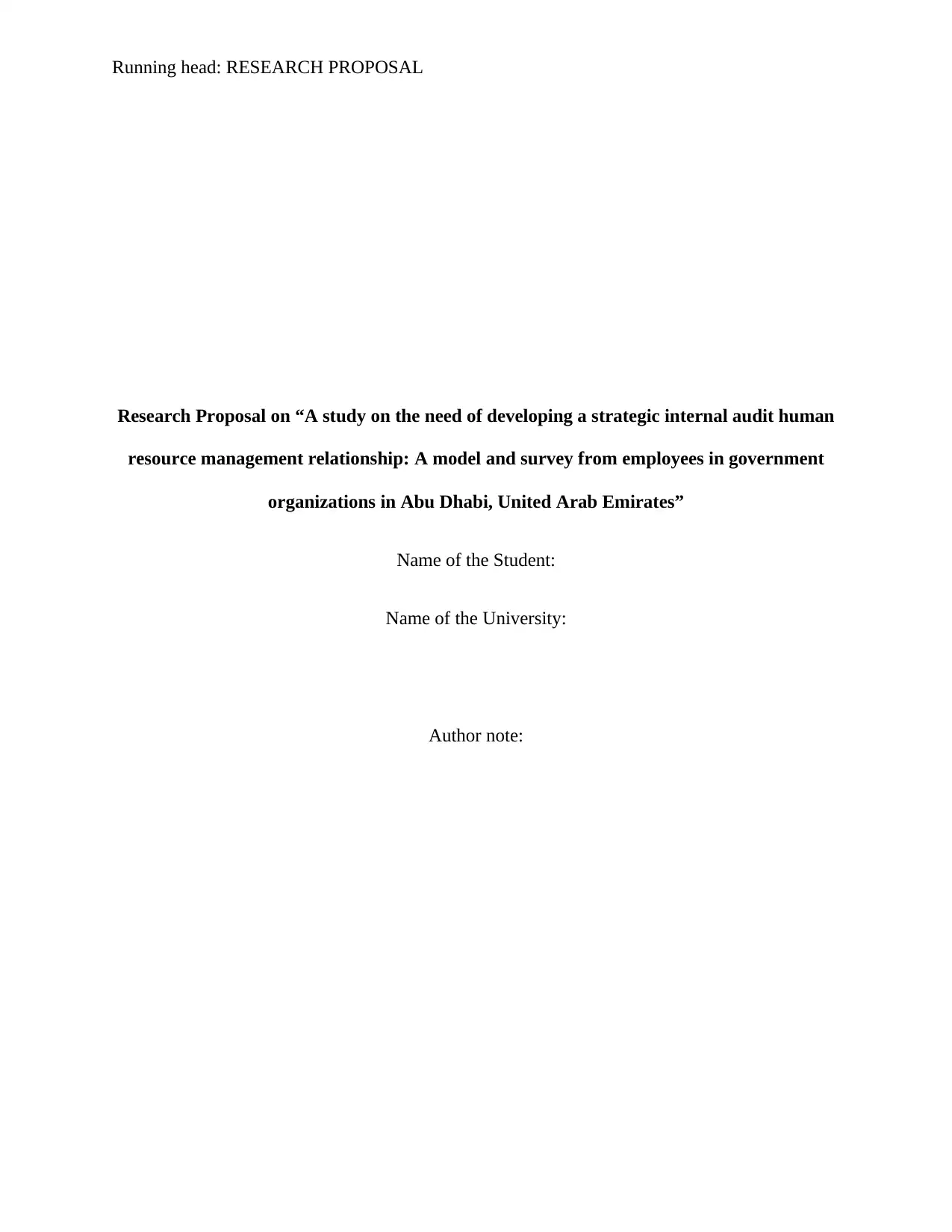
Running head: RESEARCH PROPOSAL
Research Proposal on “A study on the need of developing a strategic internal audit human
resource management relationship: A model and survey from employees in government
organizations in Abu Dhabi, United Arab Emirates”
Name of the Student:
Name of the University:
Author note:
Research Proposal on “A study on the need of developing a strategic internal audit human
resource management relationship: A model and survey from employees in government
organizations in Abu Dhabi, United Arab Emirates”
Name of the Student:
Name of the University:
Author note:
Paraphrase This Document
Need a fresh take? Get an instant paraphrase of this document with our AI Paraphraser
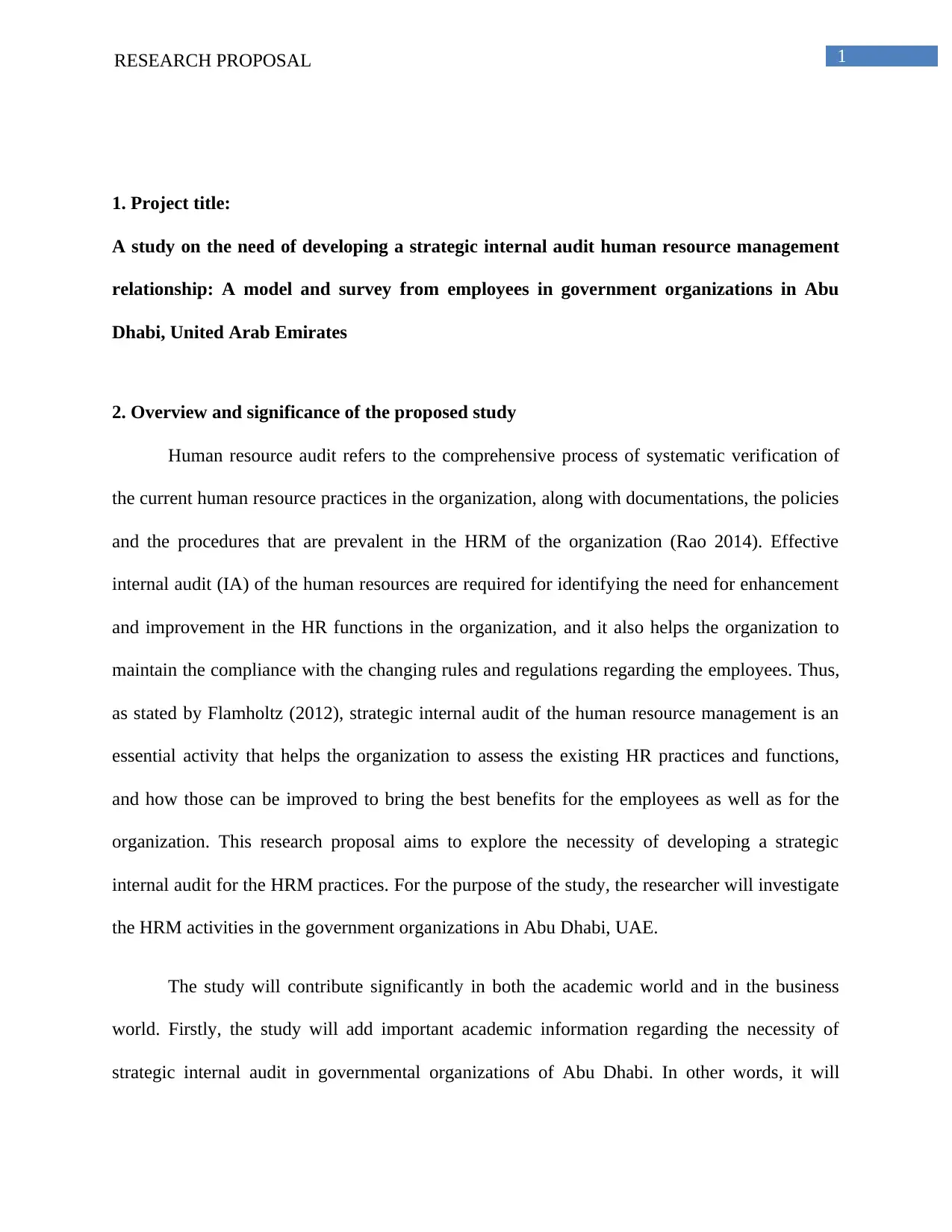
1RESEARCH PROPOSAL
1. Project title:
A study on the need of developing a strategic internal audit human resource management
relationship: A model and survey from employees in government organizations in Abu
Dhabi, United Arab Emirates
2. Overview and significance of the proposed study
Human resource audit refers to the comprehensive process of systematic verification of
the current human resource practices in the organization, along with documentations, the policies
and the procedures that are prevalent in the HRM of the organization (Rao 2014). Effective
internal audit (IA) of the human resources are required for identifying the need for enhancement
and improvement in the HR functions in the organization, and it also helps the organization to
maintain the compliance with the changing rules and regulations regarding the employees. Thus,
as stated by Flamholtz (2012), strategic internal audit of the human resource management is an
essential activity that helps the organization to assess the existing HR practices and functions,
and how those can be improved to bring the best benefits for the employees as well as for the
organization. This research proposal aims to explore the necessity of developing a strategic
internal audit for the HRM practices. For the purpose of the study, the researcher will investigate
the HRM activities in the government organizations in Abu Dhabi, UAE.
The study will contribute significantly in both the academic world and in the business
world. Firstly, the study will add important academic information regarding the necessity of
strategic internal audit in governmental organizations of Abu Dhabi. In other words, it will
1. Project title:
A study on the need of developing a strategic internal audit human resource management
relationship: A model and survey from employees in government organizations in Abu
Dhabi, United Arab Emirates
2. Overview and significance of the proposed study
Human resource audit refers to the comprehensive process of systematic verification of
the current human resource practices in the organization, along with documentations, the policies
and the procedures that are prevalent in the HRM of the organization (Rao 2014). Effective
internal audit (IA) of the human resources are required for identifying the need for enhancement
and improvement in the HR functions in the organization, and it also helps the organization to
maintain the compliance with the changing rules and regulations regarding the employees. Thus,
as stated by Flamholtz (2012), strategic internal audit of the human resource management is an
essential activity that helps the organization to assess the existing HR practices and functions,
and how those can be improved to bring the best benefits for the employees as well as for the
organization. This research proposal aims to explore the necessity of developing a strategic
internal audit for the HRM practices. For the purpose of the study, the researcher will investigate
the HRM activities in the government organizations in Abu Dhabi, UAE.
The study will contribute significantly in both the academic world and in the business
world. Firstly, the study will add important academic information regarding the necessity of
strategic internal audit in governmental organizations of Abu Dhabi. In other words, it will
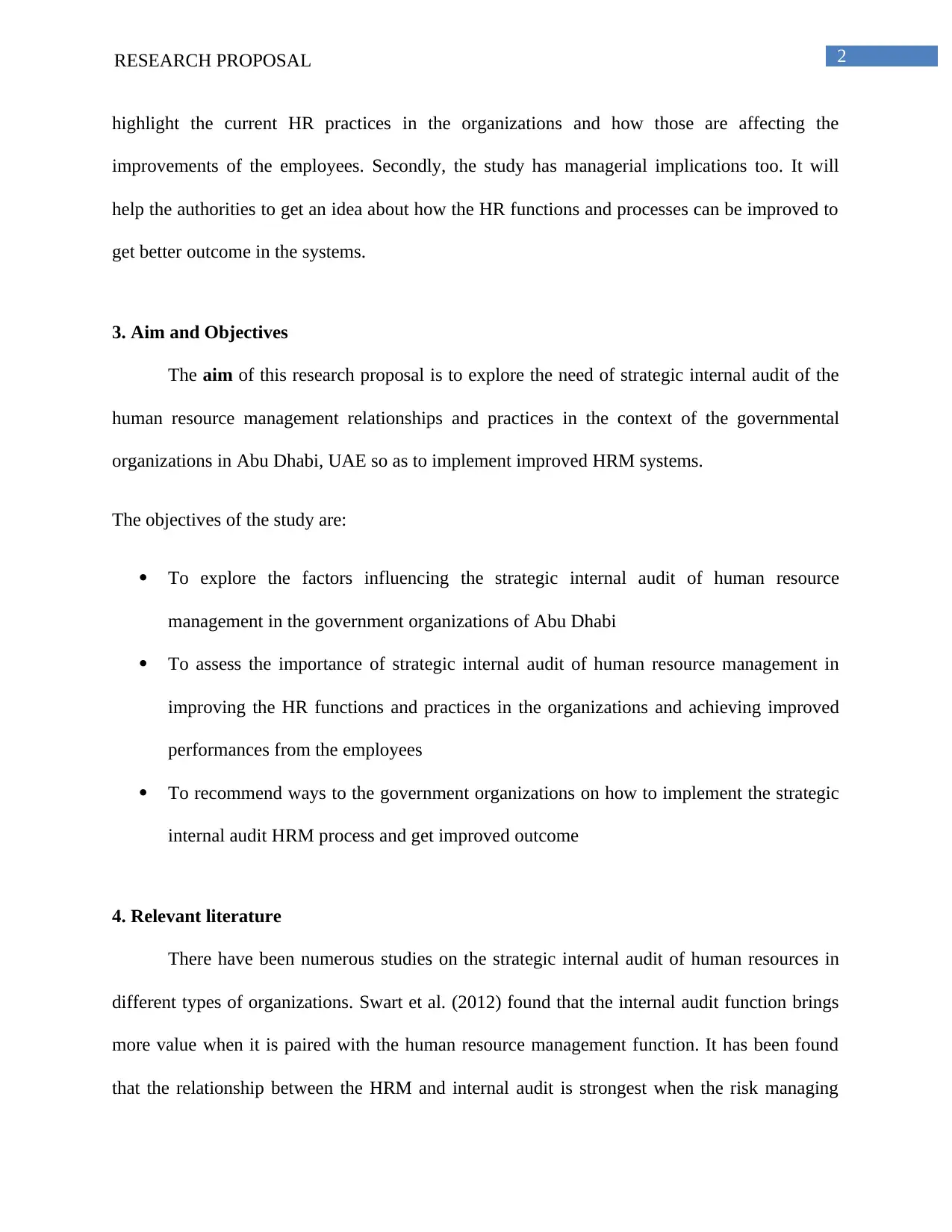
2RESEARCH PROPOSAL
highlight the current HR practices in the organizations and how those are affecting the
improvements of the employees. Secondly, the study has managerial implications too. It will
help the authorities to get an idea about how the HR functions and processes can be improved to
get better outcome in the systems.
3. Aim and Objectives
The aim of this research proposal is to explore the need of strategic internal audit of the
human resource management relationships and practices in the context of the governmental
organizations in Abu Dhabi, UAE so as to implement improved HRM systems.
The objectives of the study are:
To explore the factors influencing the strategic internal audit of human resource
management in the government organizations of Abu Dhabi
To assess the importance of strategic internal audit of human resource management in
improving the HR functions and practices in the organizations and achieving improved
performances from the employees
To recommend ways to the government organizations on how to implement the strategic
internal audit HRM process and get improved outcome
4. Relevant literature
There have been numerous studies on the strategic internal audit of human resources in
different types of organizations. Swart et al. (2012) found that the internal audit function brings
more value when it is paired with the human resource management function. It has been found
that the relationship between the HRM and internal audit is strongest when the risk managing
highlight the current HR practices in the organizations and how those are affecting the
improvements of the employees. Secondly, the study has managerial implications too. It will
help the authorities to get an idea about how the HR functions and processes can be improved to
get better outcome in the systems.
3. Aim and Objectives
The aim of this research proposal is to explore the need of strategic internal audit of the
human resource management relationships and practices in the context of the governmental
organizations in Abu Dhabi, UAE so as to implement improved HRM systems.
The objectives of the study are:
To explore the factors influencing the strategic internal audit of human resource
management in the government organizations of Abu Dhabi
To assess the importance of strategic internal audit of human resource management in
improving the HR functions and practices in the organizations and achieving improved
performances from the employees
To recommend ways to the government organizations on how to implement the strategic
internal audit HRM process and get improved outcome
4. Relevant literature
There have been numerous studies on the strategic internal audit of human resources in
different types of organizations. Swart et al. (2012) found that the internal audit function brings
more value when it is paired with the human resource management function. It has been found
that the relationship between the HRM and internal audit is strongest when the risk managing
⊘ This is a preview!⊘
Do you want full access?
Subscribe today to unlock all pages.

Trusted by 1+ million students worldwide
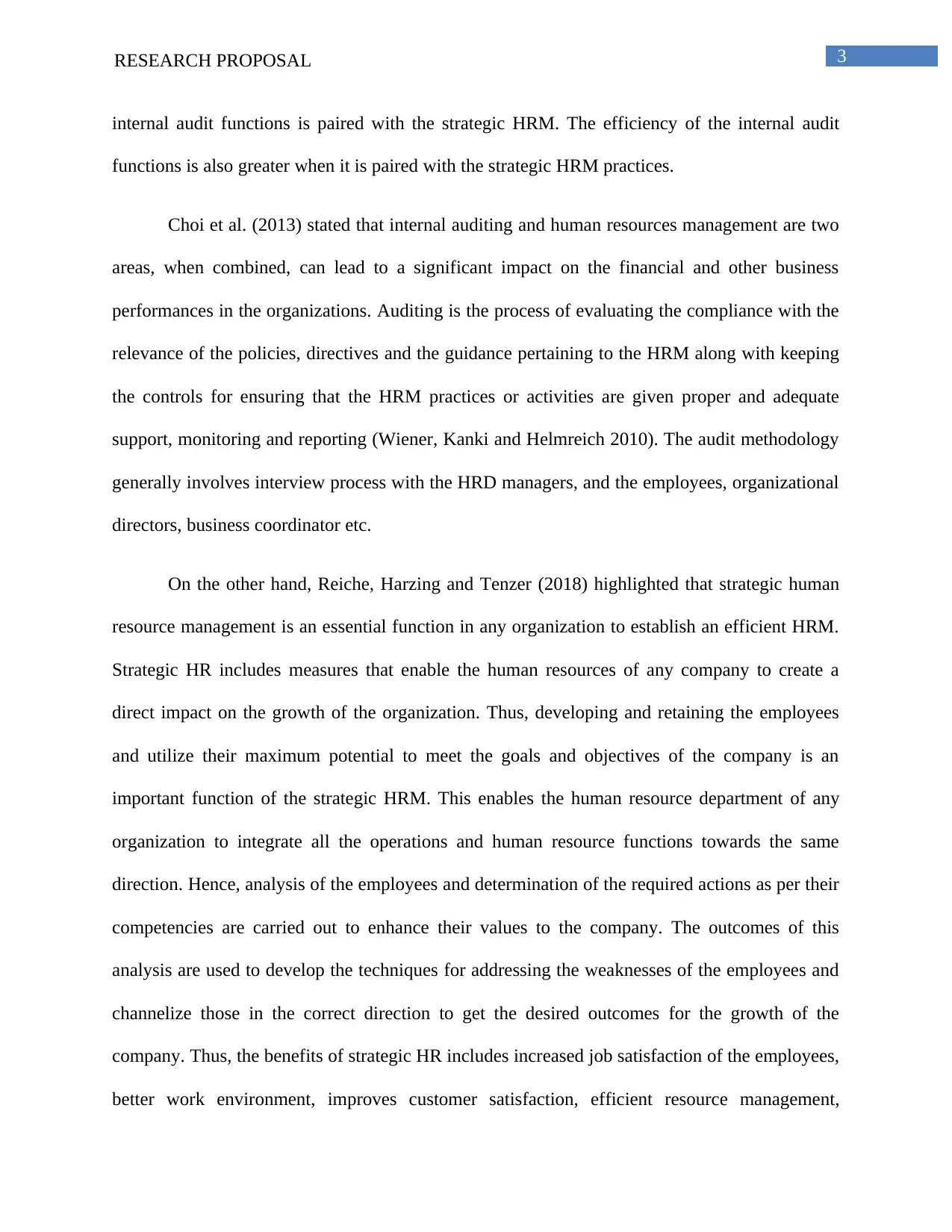
3RESEARCH PROPOSAL
internal audit functions is paired with the strategic HRM. The efficiency of the internal audit
functions is also greater when it is paired with the strategic HRM practices.
Choi et al. (2013) stated that internal auditing and human resources management are two
areas, when combined, can lead to a significant impact on the financial and other business
performances in the organizations. Auditing is the process of evaluating the compliance with the
relevance of the policies, directives and the guidance pertaining to the HRM along with keeping
the controls for ensuring that the HRM practices or activities are given proper and adequate
support, monitoring and reporting (Wiener, Kanki and Helmreich 2010). The audit methodology
generally involves interview process with the HRD managers, and the employees, organizational
directors, business coordinator etc.
On the other hand, Reiche, Harzing and Tenzer (2018) highlighted that strategic human
resource management is an essential function in any organization to establish an efficient HRM.
Strategic HR includes measures that enable the human resources of any company to create a
direct impact on the growth of the organization. Thus, developing and retaining the employees
and utilize their maximum potential to meet the goals and objectives of the company is an
important function of the strategic HRM. This enables the human resource department of any
organization to integrate all the operations and human resource functions towards the same
direction. Hence, analysis of the employees and determination of the required actions as per their
competencies are carried out to enhance their values to the company. The outcomes of this
analysis are used to develop the techniques for addressing the weaknesses of the employees and
channelize those in the correct direction to get the desired outcomes for the growth of the
company. Thus, the benefits of strategic HR includes increased job satisfaction of the employees,
better work environment, improves customer satisfaction, efficient resource management,
internal audit functions is paired with the strategic HRM. The efficiency of the internal audit
functions is also greater when it is paired with the strategic HRM practices.
Choi et al. (2013) stated that internal auditing and human resources management are two
areas, when combined, can lead to a significant impact on the financial and other business
performances in the organizations. Auditing is the process of evaluating the compliance with the
relevance of the policies, directives and the guidance pertaining to the HRM along with keeping
the controls for ensuring that the HRM practices or activities are given proper and adequate
support, monitoring and reporting (Wiener, Kanki and Helmreich 2010). The audit methodology
generally involves interview process with the HRD managers, and the employees, organizational
directors, business coordinator etc.
On the other hand, Reiche, Harzing and Tenzer (2018) highlighted that strategic human
resource management is an essential function in any organization to establish an efficient HRM.
Strategic HR includes measures that enable the human resources of any company to create a
direct impact on the growth of the organization. Thus, developing and retaining the employees
and utilize their maximum potential to meet the goals and objectives of the company is an
important function of the strategic HRM. This enables the human resource department of any
organization to integrate all the operations and human resource functions towards the same
direction. Hence, analysis of the employees and determination of the required actions as per their
competencies are carried out to enhance their values to the company. The outcomes of this
analysis are used to develop the techniques for addressing the weaknesses of the employees and
channelize those in the correct direction to get the desired outcomes for the growth of the
company. Thus, the benefits of strategic HR includes increased job satisfaction of the employees,
better work environment, improves customer satisfaction, efficient resource management,
Paraphrase This Document
Need a fresh take? Get an instant paraphrase of this document with our AI Paraphraser
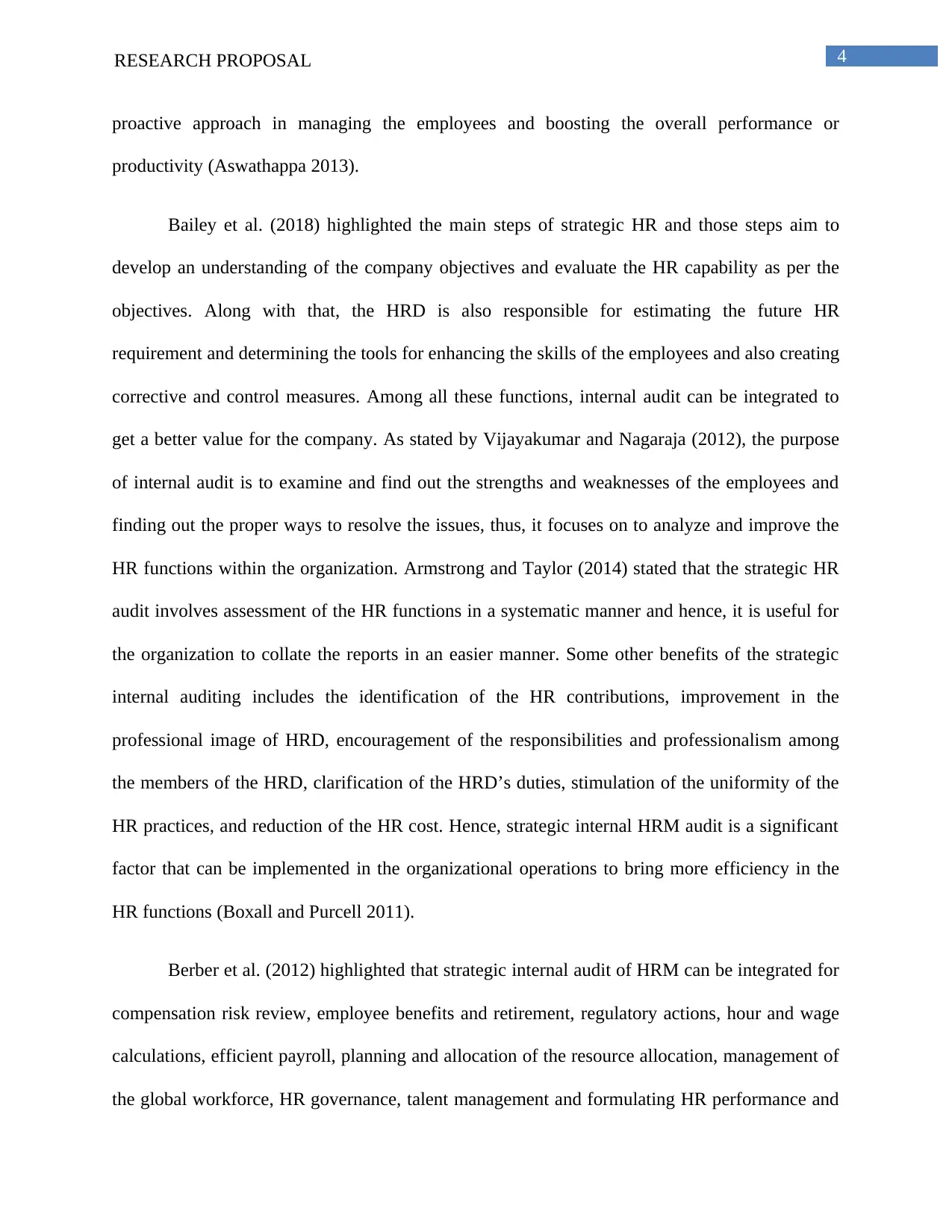
4RESEARCH PROPOSAL
proactive approach in managing the employees and boosting the overall performance or
productivity (Aswathappa 2013).
Bailey et al. (2018) highlighted the main steps of strategic HR and those steps aim to
develop an understanding of the company objectives and evaluate the HR capability as per the
objectives. Along with that, the HRD is also responsible for estimating the future HR
requirement and determining the tools for enhancing the skills of the employees and also creating
corrective and control measures. Among all these functions, internal audit can be integrated to
get a better value for the company. As stated by Vijayakumar and Nagaraja (2012), the purpose
of internal audit is to examine and find out the strengths and weaknesses of the employees and
finding out the proper ways to resolve the issues, thus, it focuses on to analyze and improve the
HR functions within the organization. Armstrong and Taylor (2014) stated that the strategic HR
audit involves assessment of the HR functions in a systematic manner and hence, it is useful for
the organization to collate the reports in an easier manner. Some other benefits of the strategic
internal auditing includes the identification of the HR contributions, improvement in the
professional image of HRD, encouragement of the responsibilities and professionalism among
the members of the HRD, clarification of the HRD’s duties, stimulation of the uniformity of the
HR practices, and reduction of the HR cost. Hence, strategic internal HRM audit is a significant
factor that can be implemented in the organizational operations to bring more efficiency in the
HR functions (Boxall and Purcell 2011).
Berber et al. (2012) highlighted that strategic internal audit of HRM can be integrated for
compensation risk review, employee benefits and retirement, regulatory actions, hour and wage
calculations, efficient payroll, planning and allocation of the resource allocation, management of
the global workforce, HR governance, talent management and formulating HR performance and
proactive approach in managing the employees and boosting the overall performance or
productivity (Aswathappa 2013).
Bailey et al. (2018) highlighted the main steps of strategic HR and those steps aim to
develop an understanding of the company objectives and evaluate the HR capability as per the
objectives. Along with that, the HRD is also responsible for estimating the future HR
requirement and determining the tools for enhancing the skills of the employees and also creating
corrective and control measures. Among all these functions, internal audit can be integrated to
get a better value for the company. As stated by Vijayakumar and Nagaraja (2012), the purpose
of internal audit is to examine and find out the strengths and weaknesses of the employees and
finding out the proper ways to resolve the issues, thus, it focuses on to analyze and improve the
HR functions within the organization. Armstrong and Taylor (2014) stated that the strategic HR
audit involves assessment of the HR functions in a systematic manner and hence, it is useful for
the organization to collate the reports in an easier manner. Some other benefits of the strategic
internal auditing includes the identification of the HR contributions, improvement in the
professional image of HRD, encouragement of the responsibilities and professionalism among
the members of the HRD, clarification of the HRD’s duties, stimulation of the uniformity of the
HR practices, and reduction of the HR cost. Hence, strategic internal HRM audit is a significant
factor that can be implemented in the organizational operations to bring more efficiency in the
HR functions (Boxall and Purcell 2011).
Berber et al. (2012) highlighted that strategic internal audit of HRM can be integrated for
compensation risk review, employee benefits and retirement, regulatory actions, hour and wage
calculations, efficient payroll, planning and allocation of the resource allocation, management of
the global workforce, HR governance, talent management and formulating HR performance and
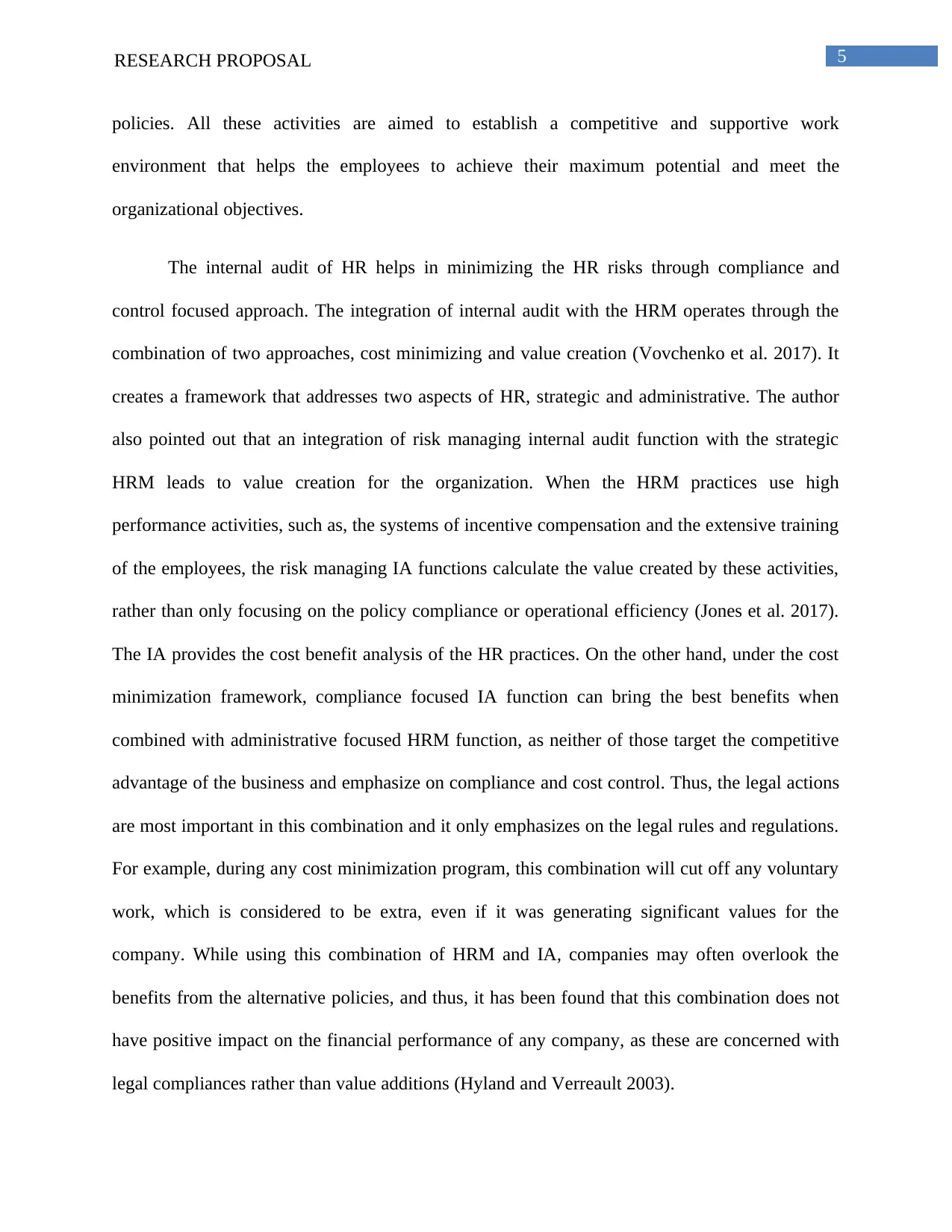
5RESEARCH PROPOSAL
policies. All these activities are aimed to establish a competitive and supportive work
environment that helps the employees to achieve their maximum potential and meet the
organizational objectives.
The internal audit of HR helps in minimizing the HR risks through compliance and
control focused approach. The integration of internal audit with the HRM operates through the
combination of two approaches, cost minimizing and value creation (Vovchenko et al. 2017). It
creates a framework that addresses two aspects of HR, strategic and administrative. The author
also pointed out that an integration of risk managing internal audit function with the strategic
HRM leads to value creation for the organization. When the HRM practices use high
performance activities, such as, the systems of incentive compensation and the extensive training
of the employees, the risk managing IA functions calculate the value created by these activities,
rather than only focusing on the policy compliance or operational efficiency (Jones et al. 2017).
The IA provides the cost benefit analysis of the HR practices. On the other hand, under the cost
minimization framework, compliance focused IA function can bring the best benefits when
combined with administrative focused HRM function, as neither of those target the competitive
advantage of the business and emphasize on compliance and cost control. Thus, the legal actions
are most important in this combination and it only emphasizes on the legal rules and regulations.
For example, during any cost minimization program, this combination will cut off any voluntary
work, which is considered to be extra, even if it was generating significant values for the
company. While using this combination of HRM and IA, companies may often overlook the
benefits from the alternative policies, and thus, it has been found that this combination does not
have positive impact on the financial performance of any company, as these are concerned with
legal compliances rather than value additions (Hyland and Verreault 2003).
policies. All these activities are aimed to establish a competitive and supportive work
environment that helps the employees to achieve their maximum potential and meet the
organizational objectives.
The internal audit of HR helps in minimizing the HR risks through compliance and
control focused approach. The integration of internal audit with the HRM operates through the
combination of two approaches, cost minimizing and value creation (Vovchenko et al. 2017). It
creates a framework that addresses two aspects of HR, strategic and administrative. The author
also pointed out that an integration of risk managing internal audit function with the strategic
HRM leads to value creation for the organization. When the HRM practices use high
performance activities, such as, the systems of incentive compensation and the extensive training
of the employees, the risk managing IA functions calculate the value created by these activities,
rather than only focusing on the policy compliance or operational efficiency (Jones et al. 2017).
The IA provides the cost benefit analysis of the HR practices. On the other hand, under the cost
minimization framework, compliance focused IA function can bring the best benefits when
combined with administrative focused HRM function, as neither of those target the competitive
advantage of the business and emphasize on compliance and cost control. Thus, the legal actions
are most important in this combination and it only emphasizes on the legal rules and regulations.
For example, during any cost minimization program, this combination will cut off any voluntary
work, which is considered to be extra, even if it was generating significant values for the
company. While using this combination of HRM and IA, companies may often overlook the
benefits from the alternative policies, and thus, it has been found that this combination does not
have positive impact on the financial performance of any company, as these are concerned with
legal compliances rather than value additions (Hyland and Verreault 2003).
⊘ This is a preview!⊘
Do you want full access?
Subscribe today to unlock all pages.

Trusted by 1+ million students worldwide
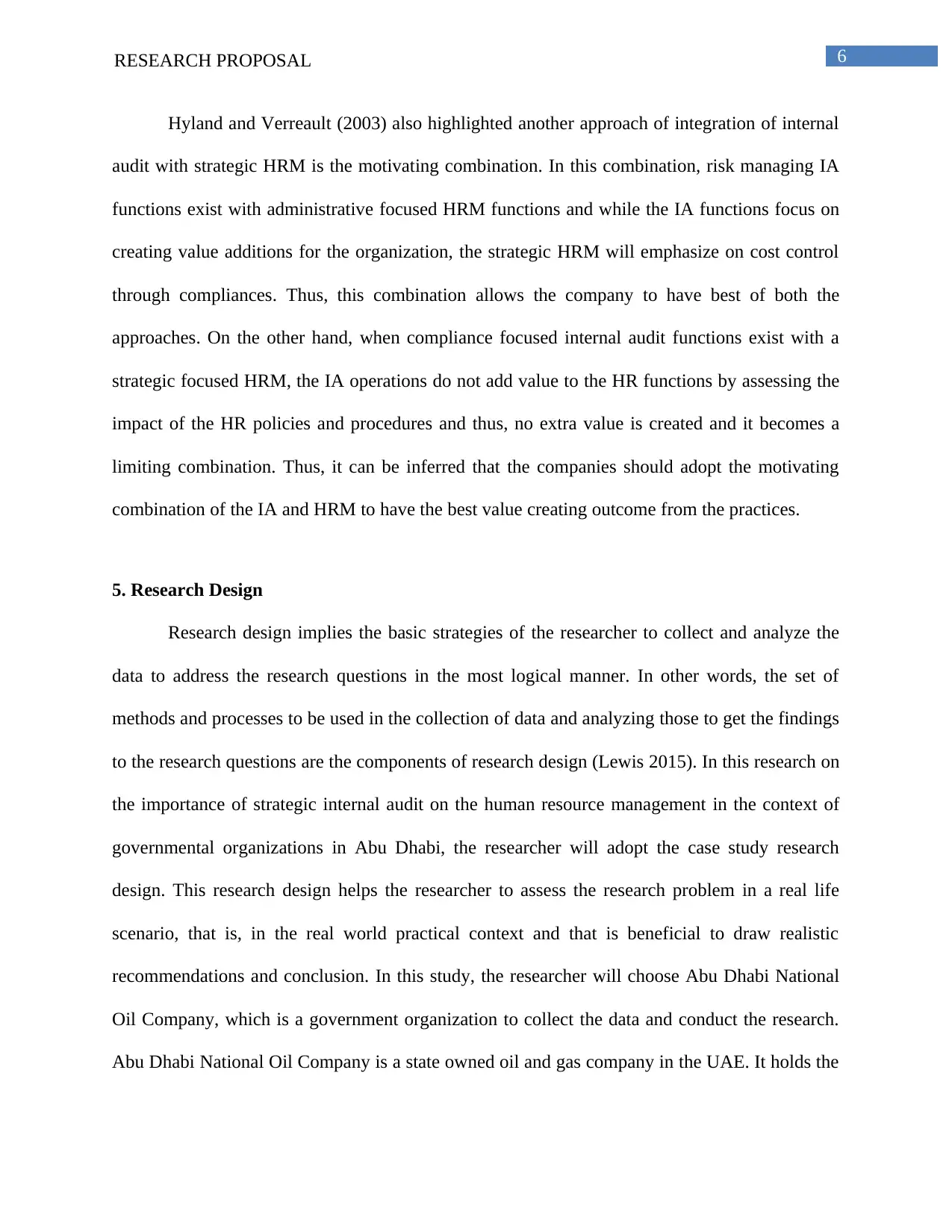
6RESEARCH PROPOSAL
Hyland and Verreault (2003) also highlighted another approach of integration of internal
audit with strategic HRM is the motivating combination. In this combination, risk managing IA
functions exist with administrative focused HRM functions and while the IA functions focus on
creating value additions for the organization, the strategic HRM will emphasize on cost control
through compliances. Thus, this combination allows the company to have best of both the
approaches. On the other hand, when compliance focused internal audit functions exist with a
strategic focused HRM, the IA operations do not add value to the HR functions by assessing the
impact of the HR policies and procedures and thus, no extra value is created and it becomes a
limiting combination. Thus, it can be inferred that the companies should adopt the motivating
combination of the IA and HRM to have the best value creating outcome from the practices.
5. Research Design
Research design implies the basic strategies of the researcher to collect and analyze the
data to address the research questions in the most logical manner. In other words, the set of
methods and processes to be used in the collection of data and analyzing those to get the findings
to the research questions are the components of research design (Lewis 2015). In this research on
the importance of strategic internal audit on the human resource management in the context of
governmental organizations in Abu Dhabi, the researcher will adopt the case study research
design. This research design helps the researcher to assess the research problem in a real life
scenario, that is, in the real world practical context and that is beneficial to draw realistic
recommendations and conclusion. In this study, the researcher will choose Abu Dhabi National
Oil Company, which is a government organization to collect the data and conduct the research.
Abu Dhabi National Oil Company is a state owned oil and gas company in the UAE. It holds the
Hyland and Verreault (2003) also highlighted another approach of integration of internal
audit with strategic HRM is the motivating combination. In this combination, risk managing IA
functions exist with administrative focused HRM functions and while the IA functions focus on
creating value additions for the organization, the strategic HRM will emphasize on cost control
through compliances. Thus, this combination allows the company to have best of both the
approaches. On the other hand, when compliance focused internal audit functions exist with a
strategic focused HRM, the IA operations do not add value to the HR functions by assessing the
impact of the HR policies and procedures and thus, no extra value is created and it becomes a
limiting combination. Thus, it can be inferred that the companies should adopt the motivating
combination of the IA and HRM to have the best value creating outcome from the practices.
5. Research Design
Research design implies the basic strategies of the researcher to collect and analyze the
data to address the research questions in the most logical manner. In other words, the set of
methods and processes to be used in the collection of data and analyzing those to get the findings
to the research questions are the components of research design (Lewis 2015). In this research on
the importance of strategic internal audit on the human resource management in the context of
governmental organizations in Abu Dhabi, the researcher will adopt the case study research
design. This research design helps the researcher to assess the research problem in a real life
scenario, that is, in the real world practical context and that is beneficial to draw realistic
recommendations and conclusion. In this study, the researcher will choose Abu Dhabi National
Oil Company, which is a government organization to collect the data and conduct the research.
Abu Dhabi National Oil Company is a state owned oil and gas company in the UAE. It holds the
Paraphrase This Document
Need a fresh take? Get an instant paraphrase of this document with our AI Paraphraser
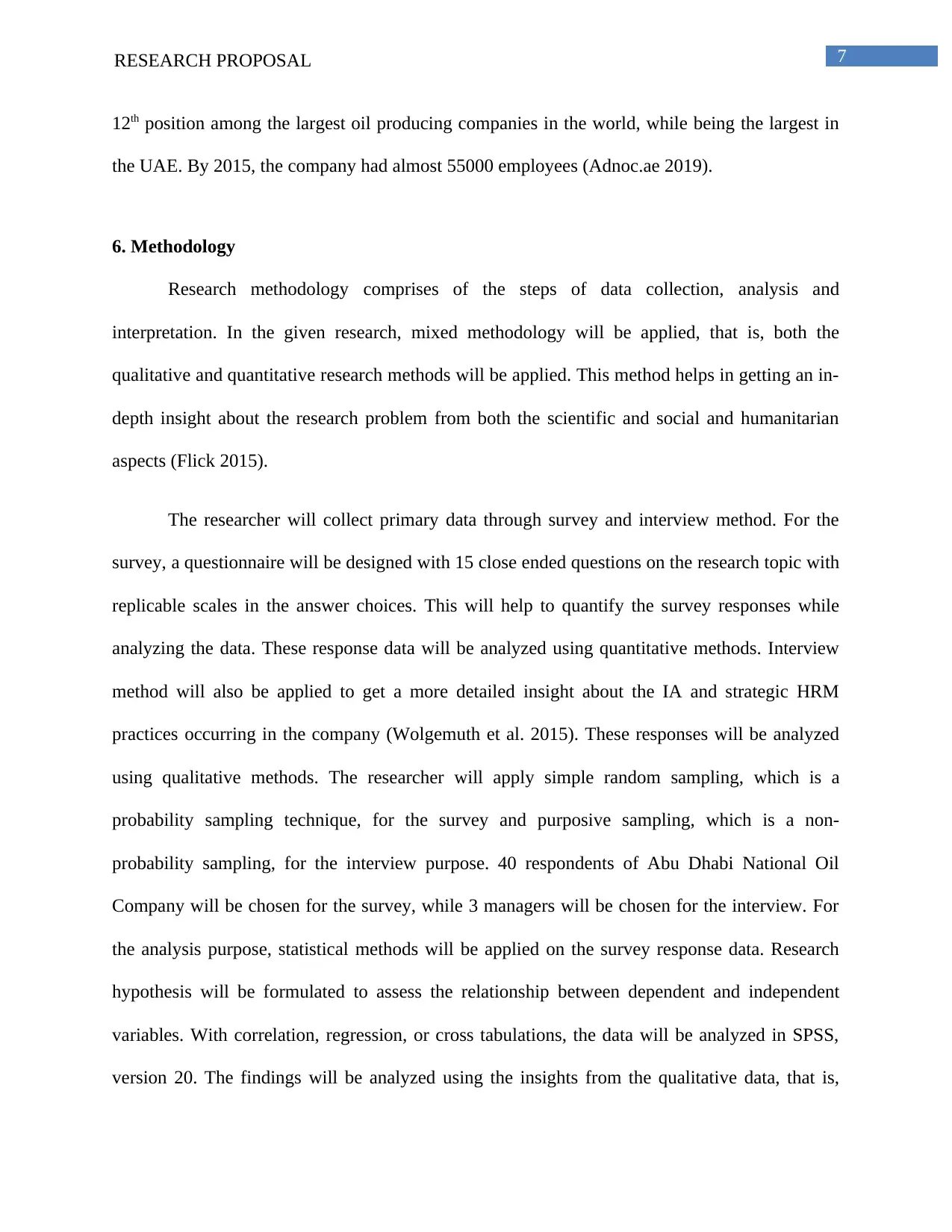
7RESEARCH PROPOSAL
12th position among the largest oil producing companies in the world, while being the largest in
the UAE. By 2015, the company had almost 55000 employees (Adnoc.ae 2019).
6. Methodology
Research methodology comprises of the steps of data collection, analysis and
interpretation. In the given research, mixed methodology will be applied, that is, both the
qualitative and quantitative research methods will be applied. This method helps in getting an in-
depth insight about the research problem from both the scientific and social and humanitarian
aspects (Flick 2015).
The researcher will collect primary data through survey and interview method. For the
survey, a questionnaire will be designed with 15 close ended questions on the research topic with
replicable scales in the answer choices. This will help to quantify the survey responses while
analyzing the data. These response data will be analyzed using quantitative methods. Interview
method will also be applied to get a more detailed insight about the IA and strategic HRM
practices occurring in the company (Wolgemuth et al. 2015). These responses will be analyzed
using qualitative methods. The researcher will apply simple random sampling, which is a
probability sampling technique, for the survey and purposive sampling, which is a non-
probability sampling, for the interview purpose. 40 respondents of Abu Dhabi National Oil
Company will be chosen for the survey, while 3 managers will be chosen for the interview. For
the analysis purpose, statistical methods will be applied on the survey response data. Research
hypothesis will be formulated to assess the relationship between dependent and independent
variables. With correlation, regression, or cross tabulations, the data will be analyzed in SPSS,
version 20. The findings will be analyzed using the insights from the qualitative data, that is,
12th position among the largest oil producing companies in the world, while being the largest in
the UAE. By 2015, the company had almost 55000 employees (Adnoc.ae 2019).
6. Methodology
Research methodology comprises of the steps of data collection, analysis and
interpretation. In the given research, mixed methodology will be applied, that is, both the
qualitative and quantitative research methods will be applied. This method helps in getting an in-
depth insight about the research problem from both the scientific and social and humanitarian
aspects (Flick 2015).
The researcher will collect primary data through survey and interview method. For the
survey, a questionnaire will be designed with 15 close ended questions on the research topic with
replicable scales in the answer choices. This will help to quantify the survey responses while
analyzing the data. These response data will be analyzed using quantitative methods. Interview
method will also be applied to get a more detailed insight about the IA and strategic HRM
practices occurring in the company (Wolgemuth et al. 2015). These responses will be analyzed
using qualitative methods. The researcher will apply simple random sampling, which is a
probability sampling technique, for the survey and purposive sampling, which is a non-
probability sampling, for the interview purpose. 40 respondents of Abu Dhabi National Oil
Company will be chosen for the survey, while 3 managers will be chosen for the interview. For
the analysis purpose, statistical methods will be applied on the survey response data. Research
hypothesis will be formulated to assess the relationship between dependent and independent
variables. With correlation, regression, or cross tabulations, the data will be analyzed in SPSS,
version 20. The findings will be analyzed using the insights from the qualitative data, that is,
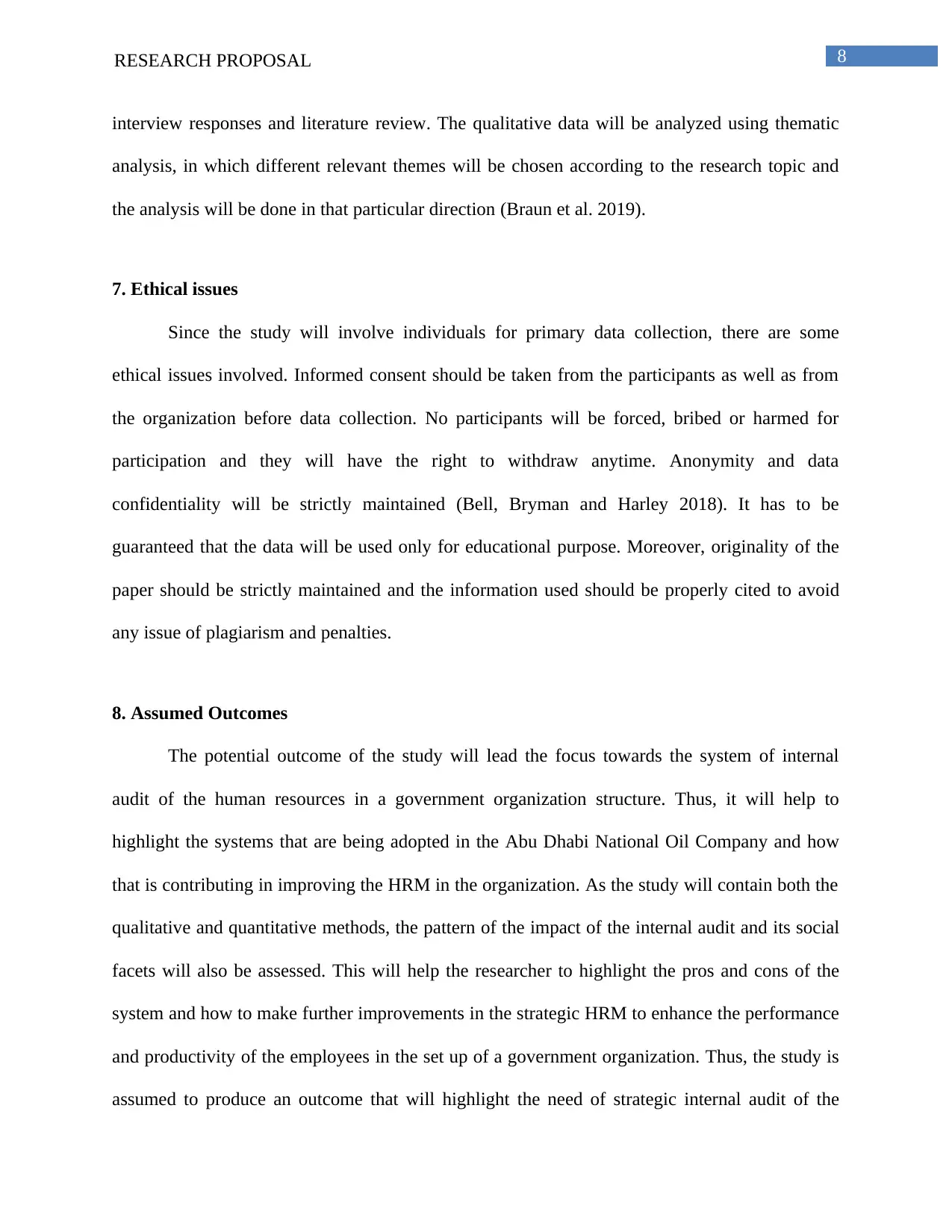
8RESEARCH PROPOSAL
interview responses and literature review. The qualitative data will be analyzed using thematic
analysis, in which different relevant themes will be chosen according to the research topic and
the analysis will be done in that particular direction (Braun et al. 2019).
7. Ethical issues
Since the study will involve individuals for primary data collection, there are some
ethical issues involved. Informed consent should be taken from the participants as well as from
the organization before data collection. No participants will be forced, bribed or harmed for
participation and they will have the right to withdraw anytime. Anonymity and data
confidentiality will be strictly maintained (Bell, Bryman and Harley 2018). It has to be
guaranteed that the data will be used only for educational purpose. Moreover, originality of the
paper should be strictly maintained and the information used should be properly cited to avoid
any issue of plagiarism and penalties.
8. Assumed Outcomes
The potential outcome of the study will lead the focus towards the system of internal
audit of the human resources in a government organization structure. Thus, it will help to
highlight the systems that are being adopted in the Abu Dhabi National Oil Company and how
that is contributing in improving the HRM in the organization. As the study will contain both the
qualitative and quantitative methods, the pattern of the impact of the internal audit and its social
facets will also be assessed. This will help the researcher to highlight the pros and cons of the
system and how to make further improvements in the strategic HRM to enhance the performance
and productivity of the employees in the set up of a government organization. Thus, the study is
assumed to produce an outcome that will highlight the need of strategic internal audit of the
interview responses and literature review. The qualitative data will be analyzed using thematic
analysis, in which different relevant themes will be chosen according to the research topic and
the analysis will be done in that particular direction (Braun et al. 2019).
7. Ethical issues
Since the study will involve individuals for primary data collection, there are some
ethical issues involved. Informed consent should be taken from the participants as well as from
the organization before data collection. No participants will be forced, bribed or harmed for
participation and they will have the right to withdraw anytime. Anonymity and data
confidentiality will be strictly maintained (Bell, Bryman and Harley 2018). It has to be
guaranteed that the data will be used only for educational purpose. Moreover, originality of the
paper should be strictly maintained and the information used should be properly cited to avoid
any issue of plagiarism and penalties.
8. Assumed Outcomes
The potential outcome of the study will lead the focus towards the system of internal
audit of the human resources in a government organization structure. Thus, it will help to
highlight the systems that are being adopted in the Abu Dhabi National Oil Company and how
that is contributing in improving the HRM in the organization. As the study will contain both the
qualitative and quantitative methods, the pattern of the impact of the internal audit and its social
facets will also be assessed. This will help the researcher to highlight the pros and cons of the
system and how to make further improvements in the strategic HRM to enhance the performance
and productivity of the employees in the set up of a government organization. Thus, the study is
assumed to produce an outcome that will highlight the need of strategic internal audit of the
⊘ This is a preview!⊘
Do you want full access?
Subscribe today to unlock all pages.

Trusted by 1+ million students worldwide
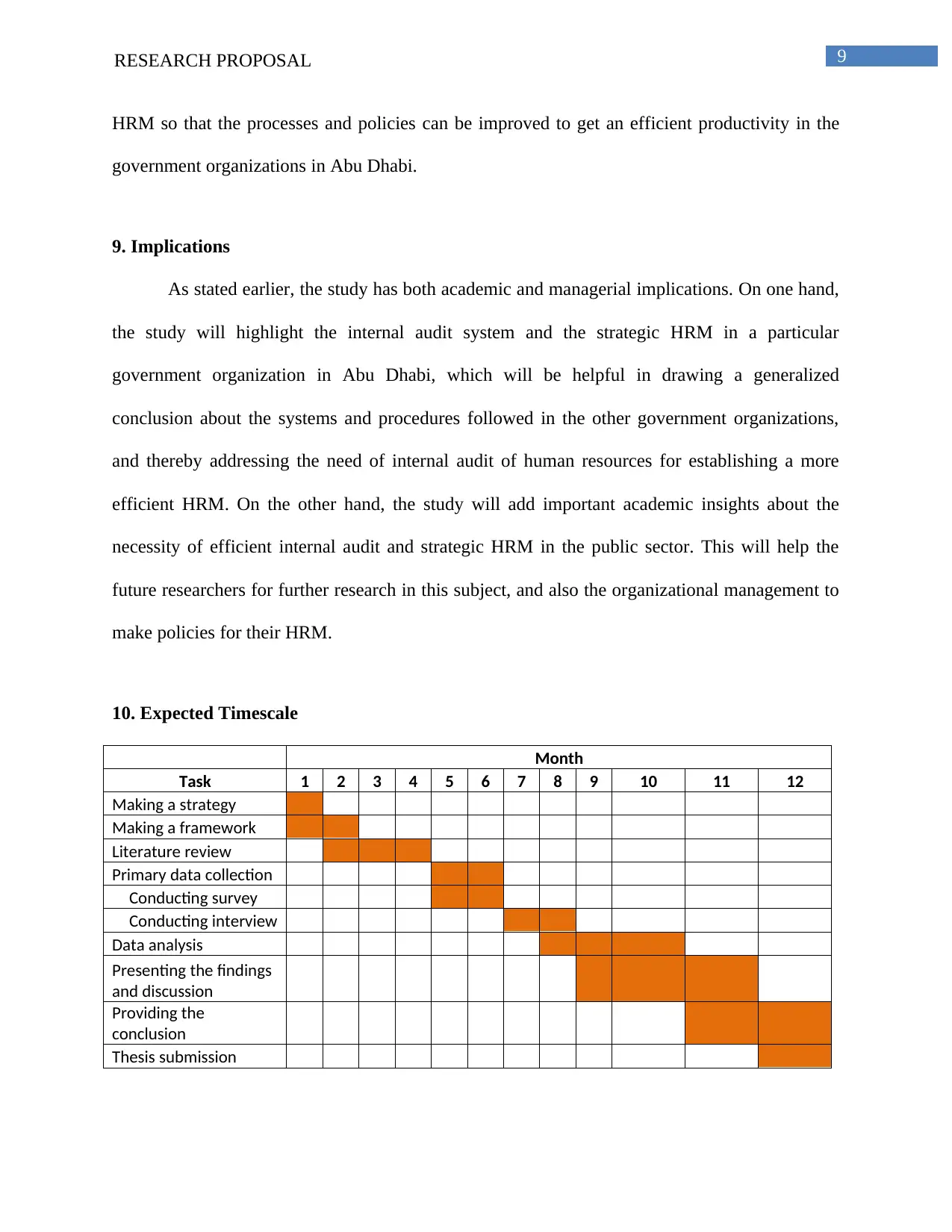
9RESEARCH PROPOSAL
HRM so that the processes and policies can be improved to get an efficient productivity in the
government organizations in Abu Dhabi.
9. Implications
As stated earlier, the study has both academic and managerial implications. On one hand,
the study will highlight the internal audit system and the strategic HRM in a particular
government organization in Abu Dhabi, which will be helpful in drawing a generalized
conclusion about the systems and procedures followed in the other government organizations,
and thereby addressing the need of internal audit of human resources for establishing a more
efficient HRM. On the other hand, the study will add important academic insights about the
necessity of efficient internal audit and strategic HRM in the public sector. This will help the
future researchers for further research in this subject, and also the organizational management to
make policies for their HRM.
10. Expected Timescale
Month
Task 1 2 3 4 5 6 7 8 9 10 11 12
Making a strategy
Making a framework
Literature review
Primary data collection
Conducting survey
Conducting interview
Data analysis
Presenting the findings
and discussion
Providing the
conclusion
Thesis submission
HRM so that the processes and policies can be improved to get an efficient productivity in the
government organizations in Abu Dhabi.
9. Implications
As stated earlier, the study has both academic and managerial implications. On one hand,
the study will highlight the internal audit system and the strategic HRM in a particular
government organization in Abu Dhabi, which will be helpful in drawing a generalized
conclusion about the systems and procedures followed in the other government organizations,
and thereby addressing the need of internal audit of human resources for establishing a more
efficient HRM. On the other hand, the study will add important academic insights about the
necessity of efficient internal audit and strategic HRM in the public sector. This will help the
future researchers for further research in this subject, and also the organizational management to
make policies for their HRM.
10. Expected Timescale
Month
Task 1 2 3 4 5 6 7 8 9 10 11 12
Making a strategy
Making a framework
Literature review
Primary data collection
Conducting survey
Conducting interview
Data analysis
Presenting the findings
and discussion
Providing the
conclusion
Thesis submission
Paraphrase This Document
Need a fresh take? Get an instant paraphrase of this document with our AI Paraphraser
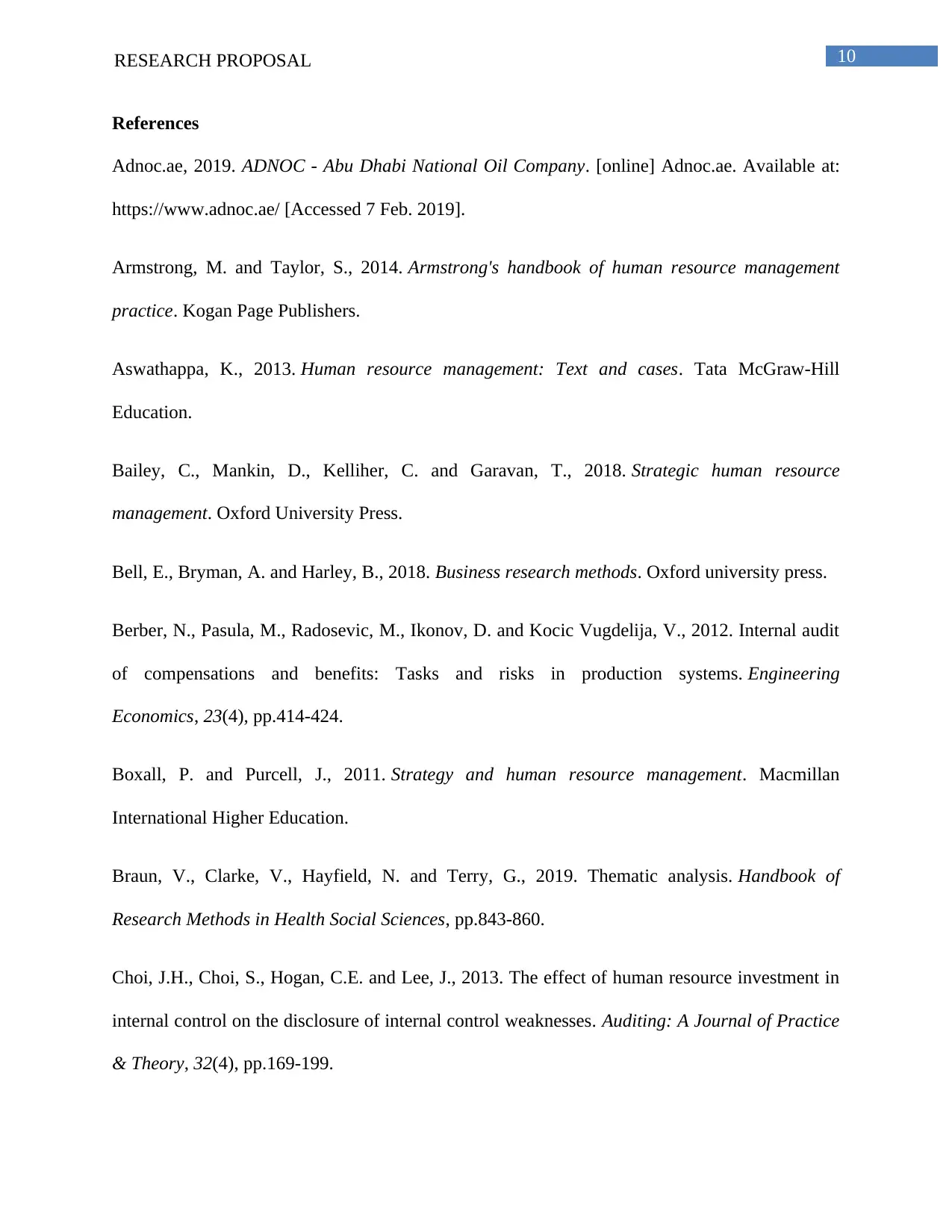
10RESEARCH PROPOSAL
References
Adnoc.ae, 2019. ADNOC - Abu Dhabi National Oil Company. [online] Adnoc.ae. Available at:
https://www.adnoc.ae/ [Accessed 7 Feb. 2019].
Armstrong, M. and Taylor, S., 2014. Armstrong's handbook of human resource management
practice. Kogan Page Publishers.
Aswathappa, K., 2013. Human resource management: Text and cases. Tata McGraw-Hill
Education.
Bailey, C., Mankin, D., Kelliher, C. and Garavan, T., 2018. Strategic human resource
management. Oxford University Press.
Bell, E., Bryman, A. and Harley, B., 2018. Business research methods. Oxford university press.
Berber, N., Pasula, M., Radosevic, M., Ikonov, D. and Kocic Vugdelija, V., 2012. Internal audit
of compensations and benefits: Tasks and risks in production systems. Engineering
Economics, 23(4), pp.414-424.
Boxall, P. and Purcell, J., 2011. Strategy and human resource management. Macmillan
International Higher Education.
Braun, V., Clarke, V., Hayfield, N. and Terry, G., 2019. Thematic analysis. Handbook of
Research Methods in Health Social Sciences, pp.843-860.
Choi, J.H., Choi, S., Hogan, C.E. and Lee, J., 2013. The effect of human resource investment in
internal control on the disclosure of internal control weaknesses. Auditing: A Journal of Practice
& Theory, 32(4), pp.169-199.
References
Adnoc.ae, 2019. ADNOC - Abu Dhabi National Oil Company. [online] Adnoc.ae. Available at:
https://www.adnoc.ae/ [Accessed 7 Feb. 2019].
Armstrong, M. and Taylor, S., 2014. Armstrong's handbook of human resource management
practice. Kogan Page Publishers.
Aswathappa, K., 2013. Human resource management: Text and cases. Tata McGraw-Hill
Education.
Bailey, C., Mankin, D., Kelliher, C. and Garavan, T., 2018. Strategic human resource
management. Oxford University Press.
Bell, E., Bryman, A. and Harley, B., 2018. Business research methods. Oxford university press.
Berber, N., Pasula, M., Radosevic, M., Ikonov, D. and Kocic Vugdelija, V., 2012. Internal audit
of compensations and benefits: Tasks and risks in production systems. Engineering
Economics, 23(4), pp.414-424.
Boxall, P. and Purcell, J., 2011. Strategy and human resource management. Macmillan
International Higher Education.
Braun, V., Clarke, V., Hayfield, N. and Terry, G., 2019. Thematic analysis. Handbook of
Research Methods in Health Social Sciences, pp.843-860.
Choi, J.H., Choi, S., Hogan, C.E. and Lee, J., 2013. The effect of human resource investment in
internal control on the disclosure of internal control weaknesses. Auditing: A Journal of Practice
& Theory, 32(4), pp.169-199.
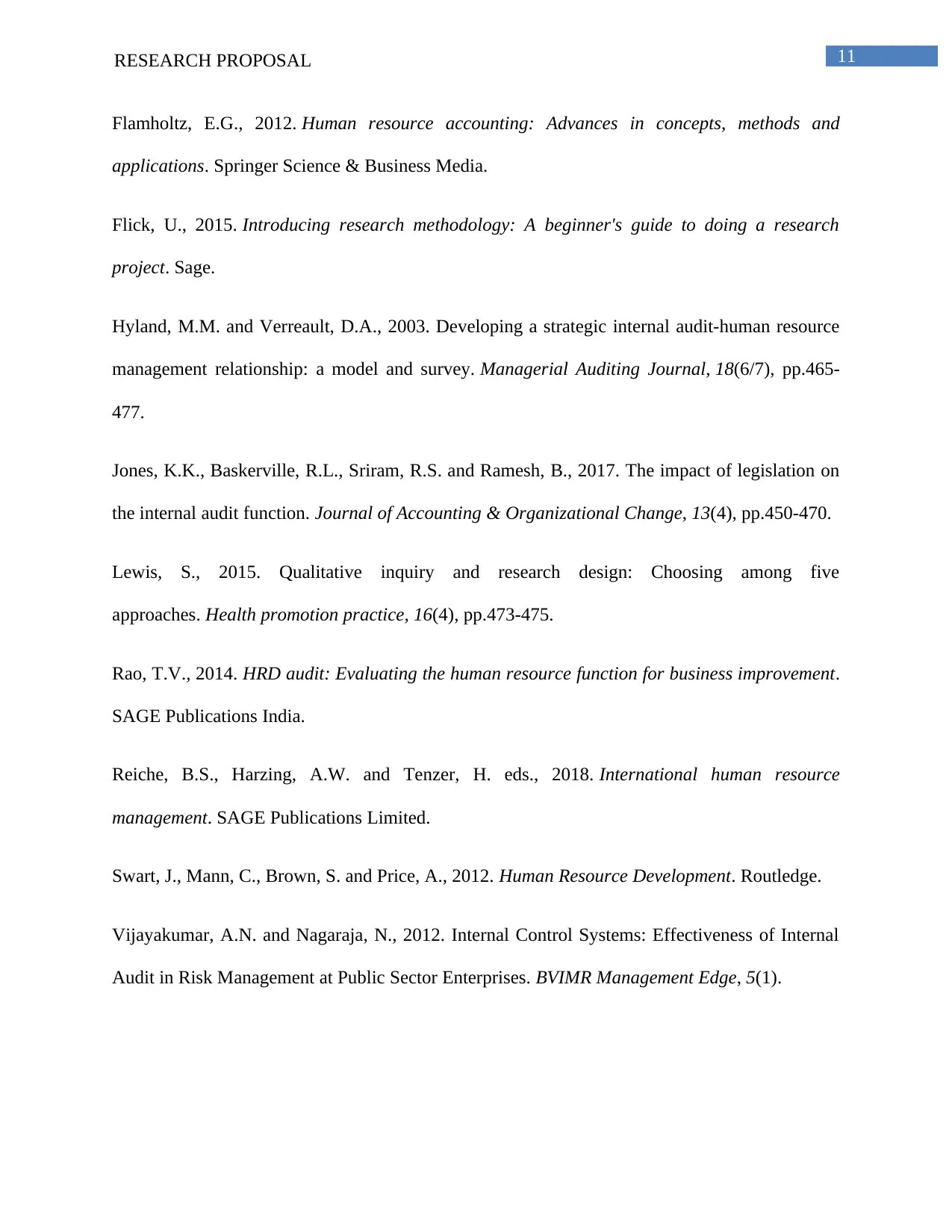
11RESEARCH PROPOSAL
Flamholtz, E.G., 2012. Human resource accounting: Advances in concepts, methods and
applications. Springer Science & Business Media.
Flick, U., 2015. Introducing research methodology: A beginner's guide to doing a research
project. Sage.
Hyland, M.M. and Verreault, D.A., 2003. Developing a strategic internal audit-human resource
management relationship: a model and survey. Managerial Auditing Journal, 18(6/7), pp.465-
477.
Jones, K.K., Baskerville, R.L., Sriram, R.S. and Ramesh, B., 2017. The impact of legislation on
the internal audit function. Journal of Accounting & Organizational Change, 13(4), pp.450-470.
Lewis, S., 2015. Qualitative inquiry and research design: Choosing among five
approaches. Health promotion practice, 16(4), pp.473-475.
Rao, T.V., 2014. HRD audit: Evaluating the human resource function for business improvement.
SAGE Publications India.
Reiche, B.S., Harzing, A.W. and Tenzer, H. eds., 2018. International human resource
management. SAGE Publications Limited.
Swart, J., Mann, C., Brown, S. and Price, A., 2012. Human Resource Development. Routledge.
Vijayakumar, A.N. and Nagaraja, N., 2012. Internal Control Systems: Effectiveness of Internal
Audit in Risk Management at Public Sector Enterprises. BVIMR Management Edge, 5(1).
Flamholtz, E.G., 2012. Human resource accounting: Advances in concepts, methods and
applications. Springer Science & Business Media.
Flick, U., 2015. Introducing research methodology: A beginner's guide to doing a research
project. Sage.
Hyland, M.M. and Verreault, D.A., 2003. Developing a strategic internal audit-human resource
management relationship: a model and survey. Managerial Auditing Journal, 18(6/7), pp.465-
477.
Jones, K.K., Baskerville, R.L., Sriram, R.S. and Ramesh, B., 2017. The impact of legislation on
the internal audit function. Journal of Accounting & Organizational Change, 13(4), pp.450-470.
Lewis, S., 2015. Qualitative inquiry and research design: Choosing among five
approaches. Health promotion practice, 16(4), pp.473-475.
Rao, T.V., 2014. HRD audit: Evaluating the human resource function for business improvement.
SAGE Publications India.
Reiche, B.S., Harzing, A.W. and Tenzer, H. eds., 2018. International human resource
management. SAGE Publications Limited.
Swart, J., Mann, C., Brown, S. and Price, A., 2012. Human Resource Development. Routledge.
Vijayakumar, A.N. and Nagaraja, N., 2012. Internal Control Systems: Effectiveness of Internal
Audit in Risk Management at Public Sector Enterprises. BVIMR Management Edge, 5(1).
⊘ This is a preview!⊘
Do you want full access?
Subscribe today to unlock all pages.

Trusted by 1+ million students worldwide
1 out of 13
Related Documents
Your All-in-One AI-Powered Toolkit for Academic Success.
+13062052269
info@desklib.com
Available 24*7 on WhatsApp / Email
![[object Object]](/_next/static/media/star-bottom.7253800d.svg)
Unlock your academic potential
Copyright © 2020–2025 A2Z Services. All Rights Reserved. Developed and managed by ZUCOL.





